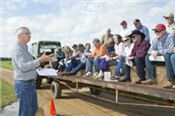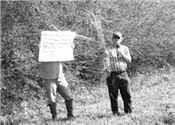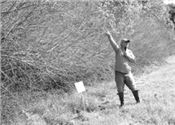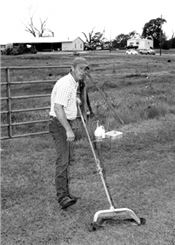|
Pasture Care, Cattle Health Highlighted At Field Day
CLINTON, LA.
LSU AgCenter scientists are trying to find ways to control two of the most common and troublesome weeds in Louisiana pastures: Chinese privet and broomsedge.
Cattle producers heard about those and several other research projects at a field day held March 30 at the Bob R. Jones-Idlewild Research Station in Clinton.
Chinese privet, which mostly grows along fencerows, is a prolific seed producer, making it easy for birds to spread the invasive plant.
“It’s a hard plant to control,” said AgCenter weed scientist Ron Strahan.
Only one herbicide, Arsenal, controls privet 100 percent. But it also kills desirable trees that may be nearby.
Strahan has been looking at other options, including the herbicides metsulfuron, Grazon Next and Remedy, all of which offer good control of privet if used with a surfactant and sprayed thoroughly. He said metsulfuron appears to be most promising, while privet treated with the more-expensive Remedy is more likely to grow back.
Applications made during the growing season – May to September – are most effective because that’s when leaves are more easily penetrated by the herbicide, Strahan said. January applications still provide some benefits.
Controlling broomsedge, another weed that produces numerous seed, is a complex undertaking. The weed is an “indicator plant” in that it typically shows up in pastures with low pH or that have not been grazed enough, said AgCenter forage specialist Ed Twidwell.
No “magic bullet” herbicides or management practices have been identified yet. Research has revealed little additional information on broomsedge control since the 1930s, when scientists in Tennessee concluded periodically clipping the weed is the best way to control it, Twidwell said.
Clipping every 30 days, along with applying lime and fertilizer, is the best treatment Twidwell said he has found so far. It’s also important to maintain a vigorous forage stand, which helps reduce the number of broomsedge plants by creating competition, he said.
Producers should ensure they apply herbicides and other farm chemicals properly.
“Improper calibration is sometimes the reason why people do not achieve the results that they want,” said Kenny Sharpe, AgCenter agent in Livingston Parish.
He demonstrated how to calibrate sprayers using the “1/128 calibration method,” which involves adjusting nozzle pressure so that one gallon is sprayed per 1/128 acre. He also recommended using GPS to calculate exact acreage so that appropriate amounts of inputs are applied.
Jeff Gurie, who manages the livestock farm at the AgCenter Dean Lee Research Station in Alexandria, told about an ongoing study of “environmentally smart,” or controlled-release, nitrogen fertilizer. It is a urea product that is coated with polymers. Controlled-release nitrogen may require fewer applications, he said, because it is less susceptible to volatilization and more can be put out at one time.
In the winter ryegrass season, Gurie was able to graze plots treated with the controlled-release fertilizer six times compared to only five times on plots treated with urea alone and urea with the Agrotain nitrogen stabilizer.
Data collected so far show no significant differences between controlled-release and regular fertilizers in terms of the amount of nitrate runoff they cause or the level of protein and dry matter in ryegrass, he said.
Jonathan Roberts, a Louisiana Department of Agriculture and Forestry veterinarian, advised field day attendees to take precautions against parasites, diseases and stress, especially as the hot summer approaches. Herds should be vaccinated according to farm-specific needs, and good handling practices should be used to avoid stressing animals.
Nutrition is another important consideration. Cattle that aren’t fed adequately will not perform well during breeding season, which will be reflected in their calves, Roberts said.
“Whatever you feed your cow while she’s pregnant can actually determine how that calf produces,” he said.
Cattle producers should be familiar with the different stages of calving and know when they should intervene or call for professional assistance, said Glen Gentry, resident coordinator of the Idlewild station.
“You can do everything right … but still, from time to time, you’re going to have issues,” he said.
Heifers tend to have more difficulties than cows, for example. And large calves can cause labor to last too long, a situation in which the producer must know how to take action safely and quickly.
AgCenter agent Donna Morgan encouraged attendees to join the Louisiana Master Farmer and Master Cattleman programs, which teach about good management practices and conservation.
Phil Elzer, AgCenter associate vice president and director of the School of Animal Sciences, said state budget cuts continue to cause uncertainty about the future of higher education. Still, the undergraduate animal science program at LSU has remained strong, with more than 400 students enrolled.
The School of Animal Sciences recently hired three new faculty members, who will focus their work on beef cattle.
“We have a commitment to the cattle industry,” Elzer said. ∆

LSU AgCenter county agent Kenny Sharpe, left, speaks about sprayer calibration to attendees at a cattle and forage
field day on March 30 at the Bob R. Jones-Idlewild Research Station in Clinton.
Photo by Olivia McClure/LSU AgCenter

LSU AgCenter forage specialist Ed Twidwell, right, displays a broomsedge plant during a cattle and
forage field day held March 30 at the Bob R. Jones-Idlewild Research Station in Clinton. AgCenter weed
scientist Ron Strahan is obscured by the poster, which details research performed in the 1920s and 1930s on broomsedge control.

LSU AgCenter weed scientist Ron Strahan speaks about a thicket of Chinese privet, an invasive plant that
typically grows along fencerows, that was treated with the herbicide Remedy. He was speaking during a
cattle and forage field day held March 30 at the Bob R. Jones-Idlewild Research Station in Clinton.

Glen Gentry, AgCenter animal scientist and coordinator of the Bob R. Jones-Idlewild Research Station in Clinton,
displays a “calf jack” during a cattle and forage field day held at the station on March 30. The device is sometimes
used to deliver calves.
|
|